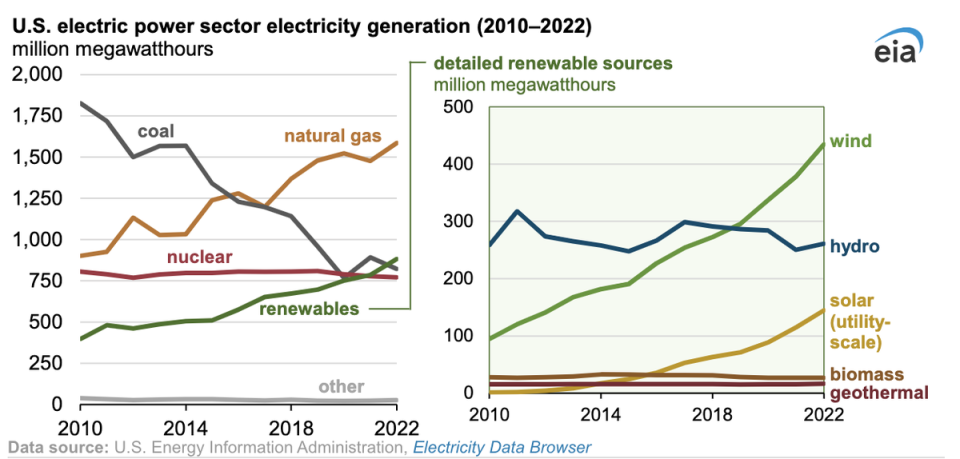Renewable energy use surges past coal for first time in the US

More Americans’ electricity was generated by renewable energy than coal last year, according to the latest government data.
The use of wind, solar, hydro, biomass and geothermal also jumped ahead of nuclear power generation, reported the Energy Information Administration (EIA) on Monday, after first doing so in 2021.
The booming sectors of wind and solar were driving the transition to clean energy from planet-heating fossil fuels.
Combined wind and solar increased their share of power sector electricity generation from 12 per cent in 2021 to 14 per cent in 2022.
Hydropower stayed the same at 6 per cent in 2022 and biomass and geothermal remained at less than 1 per cent.
The share of coal-fired power dropped from 23 per cent in 2021 to 20 per cent in 2022 as some plants were retired, and others used less.
“This booming growth is driven largely by economics,” Gregory Wetstone, president and CEO of the American Council on Renewable Energy told the Associated Press.
“Over the past decade, the levelised cost of wind energy declined by 70 per cent, while the levelised cost of solar power has declined by an even more impressive 90 per cent.”
He added: “Renewable energy is now the most affordable source of new electricity in much of the country.”
The electric power sector includes major utility companies and independent power producers but not industrial, commercial, or residential sectors, such as rooftop solar panels, for example.
Nuclear power declined from 20 per cent in 2021 to 19 per cent in 2022 which EIA attributed to the retirement of the Palisades plant in Michigan.

Yet fossil fuels still maintain a tight grip. Gas remained the largest source of US electricity generation, increasing its share year-on-year from 37 per cent to 39 per cent.
What’s more, it’s Republican-led states leading the clean energy charge.
Texas produced more wind-generated power than any other state last year, according to EIA statistics, at 26 per cent of the US total. This was followed by Iowa (10 per cent), and Oklahoma (9 per cent).
The Traverse Wind Energy Center in Oklahoma, one of the US’s largest-ever wind farms, also came online in 2022. It’s expected to generate enough electricity to power an estimated 300,000 homes each year.
California remained the largest in solar power, producing 26 per cent of the US total. This was followed by Texas (16 per cent) and North Carolina (8 per cent).
Several of the country’s largest solar plants have opened in the last three years in Texas, EIA noted.
Clean energy also looks set to grow in 2023, according to EIA data this month.
The latest forecast shows wind power growing to 12 per cent in 2023, and solar up to 5 per cent.
Meanwhile, coal will see further declines from 20 per cent to 17 per cent, while gas will stick at 39 per cent.
Electric power accounts for around 25 per cent of total US greenhouse gas emissions, according to the EPA.
The US has a goal of reaching a 100 per cent decarbonized electric grid by 2035 – which will mean not only increasing renewable energy but boosting battery storage due to its intermittent nature.
The Inflation Reduction Act 2022 is investing $369bn into fighting climate change including transitioning the power grid away from fossil fuels.


